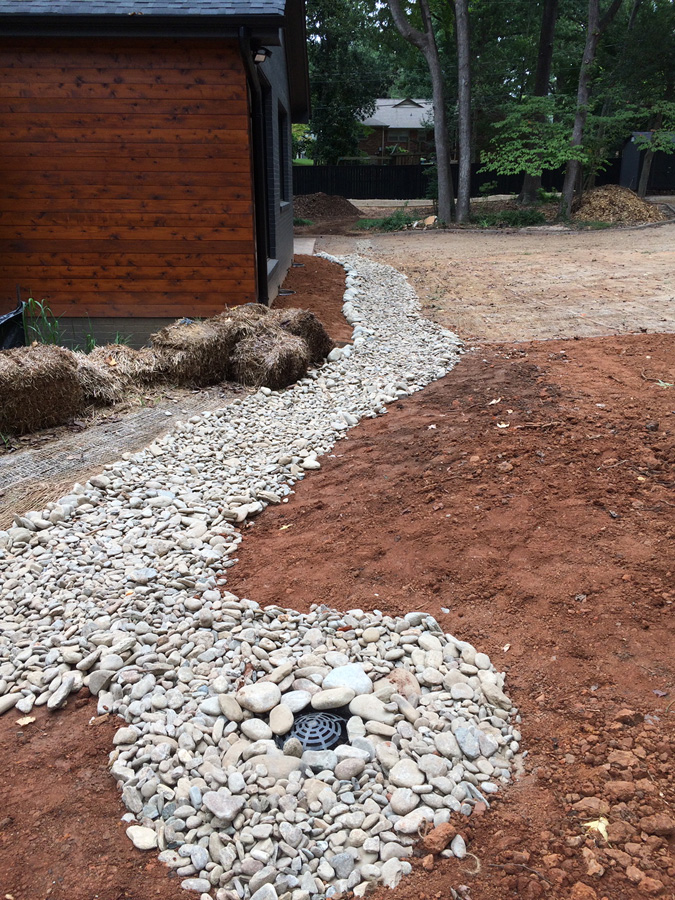With all the wet weather we’ve been having in the Carolinas, you may be experiencing drainage issues, leaving your yard a soggy or muddy mess. Our clay soils can become super saturated. Even a yard that previously drained well can become a swamp with nowhere for the water to go. There are many solutions for drainage issues depending on your site and drainage problem.
Basically there are two types of drainage issues: surface and sub-surface water.
Surface water puddles or pools in your yard, on your driveway or walkways. The water has nowhere to go due to grade, soil issues or obstructions.
Subsurface water may be a more complex problem. Water collects below the visible surface of your yard. In some cases, if not corrected, this could cause damage to foundations, paved walkways, driveways and more.
Solutions to your drainage problem will depend on the individual situation at your site. Here are some possible solutions:
Surface Drainage Systems
Surface drainage systems are typically the simplest solution. They are most often used when the slope of the property allows the water to be drained off-site through grading. Water is directed by slope or swales, shallow drainage channels which funnel water off site or into a sub-surface drainage system.
Swales or Drainage Channels
Swales can be grassed, or if they carry a high volume of water, turned into a dry creek bed. A dry creek bed can be decorative, functional and add interest to your landscape.
Permeable Pavers
Permeable pavers are used to minimize run-off water in paved areas. They are designed to allow water to seep through them and be collected into ground water or collected into a catchment system and either be held for use on-site or drained off-site.
Surface drainage systems are frequently combined with sub-surface drainage systems to collect and carry water off site.
Sub-Surface Drainage Systems
There are many components to sub-surface drainage solutions. Some or all of them may be used to remediate water issues on a site.
French Drains
A French drain is used to remove water that is collecting either in a low area or against a wall or foundation. A trench is dug in the area where water is collecting, and drainage gravel and perforated pipe encased in filter fabric are installed to collect water. They are then connected to a solid collector pipe that either drains into another drainage structure or off-site.
Catch Basins
Catch basins are drop inlets which are installed where point sources of water can be identified. A low spot is created in the turf, a natural area, or at the terminus of a dry creek bed. The catch basin is set to collect the water, and is connected to a solid collector pipe that either drains into another drainage structure or off-site.
Trench Drains
Trench drains are a type of drop inlet which are typically 4” or 6” wide, and are of varied length, typically no less than 2’ long. They are useful when there is a drainage issue at the edge of a paved area or leading into a garage to keep water from flowing into a pool, patio or garage. Water is then carried using sub-surface piping to drain off-site.
Piping of Downspouts Away from Foundations
Frequently downspouts are connected to subsurface piping to be drained away from the foundation of the home and carried off-site. Collection pipes from downspouts can be combined with other drainage elements or may be the only drainage needed on a site.
Flo-Wells and Dry Wells
In some instances water cannot be drained off-site and must be funneled into a collection basin. These are pits which are dug in a low spot on-site and filled with clean drainage gravel, and/or possibly a vault which has a drop inlet on top and is surrounded by clean drainage gravel. The water is then held sub-surface as it slowly drains into the surrounding soil.
If you need help managing good drainage, give us a call so we can access your yard. You'll be glad you did so you can enjoy your yard to its fullest potential.




